Johnson Matthey Silver Bar: Facts, Pricing, History, and Details (2025)
Disclosure: We are reader-supported. If you purchase from a link on our site, we may earn a commission. Learn more
Johnson Matthey was once one of the most trusted names in silver bullion production. A British company founded in 1817, it built a global reputation for refining high-quality gold and silver bars. However, in 2015, Johnson Matthey officially exited the precious metals business, selling its bullion division to Asahi Holdings of Japan. Today, their bars remain highly valued on the secondary market for their purity, craftsmanship, and historical prestige.
Looking to Buy Gold Bars or Coins in Your IRA?
Request your free Gold IRA Kit from GoldenCrest Metals and learn how to invest in gold and silver bars inside your retirement account—safely and tax-advantaged.
The organization was founded in 1817 as a gold assaying company in London, and has worked in precious metals ever since. Unlike many precious metals bullion producers, Johnson Matthey is an incredibly diverse organization which has operations in such fields as automotives, medicine and pharmaceuticals, among others.
The nearly 200-year old company employs some 10,000 people worldwide and their gold and silver bullion are highly valued in nearly every market.
As of 2025, Johnson Matthey plc remains a publicly traded company on the London Stock Exchange (LON:JMAT), but its focus has shifted entirely to clean energy technologies, battery materials, and hydrogen-related innovations. It no longer has any involvement in precious metals refining or bullion production. The company is publicly traded (LON:JMAT) and recently increased its stock dividend to $0.66 as of June 2022. The company is also known for its riskier investments, such as recent investments in hydrogen chemical engineering projects.
Development, Introduction and History
Despite opening their doors in 1817, Johnson Matthey didn’t truly explode onto the precious metals scene until 1946, when they entered into an agreement with the British government to become the sole producers of all silver coins in the UK. Ever since, Johnson Matthey bullion has been world-renowned for their quality and variety.
Though Johnson Matthey does offer gold bars, the company has always been better known for their silver products. Their silver bars are popular in part because of the credibility of the JM brand, but the uniqueness of their silver products is a direct consequence of their enormous variety in size and multiple minting locations.

At one point or another in their history, Johnson Matthey silver bars were produced at various refineries in Australia, Belgium, Hong Kong and the United Kingdom. Additionally, these different mints created all manner of weight denominations, designs and levels of refinement in their products.
Johnson Matthey ceased all silver and gold bullion production in 2015. Since then, no new bars have been minted or cast under the JM brand. Existing bars are now only available on the secondary market, often commanding premiums due to their brand reputation and limited supply.
Johnson Matthey Silver Bar Physical Characteristics
Bar Design
Variety is the name of the game with Johnson Matthey bars – in both size and look. Most are fairly plainly designed, though some very unique and attractive designs exist for all kinds of special occasions.
In contrast to the intricate, multiple-pressed and often expensive minting process used for other forms of gold bullion, Johnson Matthey gold bars often have a very simplistic design. However, the design of the bars is not completely uniform, and more intricate designs can be found if investors value a more polished look and feel.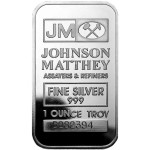
The most iconic Johnson Matthey bar is the flat, rectangular 1 oz silver bar. It features the “JM” initials alongside the crossed hammers logo, with inscriptions that typically include the company name, weight, purity (.999 fine silver), and sometimes a unique serial number. Due to their limited production, these bars are increasingly valued by collectors and investors alike, the front (“obverse”) side of the bar carries the initials “JM” next to the Johnson Massey logo containing two crossed hammers.
The full name “JOHNSON MATTHEY ASSAYERS & REFINERS” reads underneath the logo, followed by the fineness “FINE SILVER 999” to indicate the quality of the bullion. After the weight (“1 OUNCE TROY”), some Johnson Matthey bars carry a unique serial number, though not all do.
Johnson Matthey officially exited the precious metals refining and bullion business in 2015, selling its operations to Asahi Holdings. While JM bars are no longer produced, they remain highly sought after in the secondary market for their quality and trustworthiness.
Specifications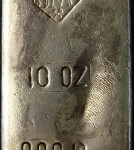
There are too many varieties of Johnson Matthey Silver Bars to cover here effectively. Some websites (such as this one) work to collect as many different types of their products; the variety is quite stunning and does present some difficulties in authenticating a Johnson Matthey purchase.
Regardless of weight or shape, all Johnson Matthey Silver Bars carry a fineness of .9999 (99.99% silver content).
Johnson Matthey Silver Bar Pricing
Unlike many bullion coins, silver bars are not used as legal tender, and therefore carry no transactional value. Still, silver bars contain certain advantages over silver coins as an option for investing in physical silver.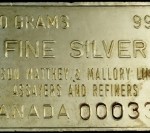
The mintage of bullion bars, such as the Johnson Matthey Silver Bar, can be much lower than the minting cost of bullion coins. This means that the market price (value of the bar, comprised of the value of its silver content plus production and shipping costs) tends to be very close to the spot price (trading value) of silver. Silver bars can be a very cost effective way to own silver.
The market price is used to determine value inside of an investment portfolio. Since silver prices fluctuate daily, the value of Johnson Matthey Silver Bars will also fluctuate daily. You can check out our home page for live metal pricing.
The low production costs of most Johnson Matthey bars result in their silver bars carrying some of the lowest premiums over spot price in the bullion world.
Investing in Johnson Matthey Silver Bars Through an IRA
The IRS allows Individual Retirement Accounts (IRAs) that meet specific requirements to carry precious metal bullion as an investment in a portfolio. Often referred to as a “precious metals IRA”, these accounts are self-directed and are only IRS-approved bars and coins are the only metals that are eligible to be included.
Want to Buy Gold or Silver Inside Your IRA?
Get your free Gold IRA Kit from GoldenCrest Metals — one of America’s most trusted Gold IRA providers. Learn how to safely invest in precious metals inside your retirement account with expert guidance.
Johnson Matthey Silver Bars are approved for inclusion in a precious metals IRA—if they were produced when JM was an active mint and meet IRS standards for purity (.999 or higher). Since production has ceased, all eligible bars are now purchased on the secondary market and must still meet IRS requirements for size, purity, and storage. Since the spot price of silver tends to be much lower than gold, silver can be a more affordable alternative hedge for those interested in precious metals.
Johnson Matthey Silver Bars meet the minimum purity requirements established in Internal Revenue Code section 408(b). For IRA investing, the owner of the account is required to make an initial purchase of at least $5,000 of qualifying bullion, and each subsequent purchase must be at least $1,000.
When you make a purchase of Johnson Matthey Silver Bars (or any precious metals designated for an IRA), the IRS further requires that all coins and/or bars be held in a qualifying “depository.” The depository is responsible for the security and maintenance of the bullion.
Those with an existing IRA have the option of transferring or rolling over funds into a precious metals IRA.
Johnson Matthey bars are a very liquid bullion asset, able to be purchased and sold through dealers across the world. Their bars are registered with exchanges such as the LMBA, COMEX and APMEX. To avoid purchasing any counterfeit silver bars, it is recommended to purchase directly from reputable bullion dealers or from the Johnson Matthey website.
Sign up to learn more. It's free!
If you're worried about the economy and want to learn tips on how to protect your retirement savings in case of another systemic collapse, sign up to our monthly newsletter now for free!
We cover topics such as: precious metals investing, inflation, currency devaluation, national debt, the Fed's financial policies, world politics, and much more. Join now and we'll send you a free PDF report to help you avoid common scams and pitfalls that often impact newcomers to gold and silver investing.
Already decided to invest in silver? Before opening a silver IRA, be sure to check which Johnson Matthey bars are still eligible under IRS rules. Only bars that meet strict purity and documentation standards can be included—mistakes here can result in costly penalties. See our complete list of IRA-approved silver products before you buy.
Ready to invest in physical gold?
Request your free Gold IRA Kit from GoldenCrest Metals and learn how to own gold bars inside your retirement account.
with one of America's most trusted precious metals providers. But before doing so, take a look at which silver products are eligible for IRA inclusion—investing in an ineligible silver bar or coin could result in costly IRS-imposed fines or penalties.



 Silver
Silver Gold
Gold Platinum
Platinum Palladium
Palladium Bitcoin
Bitcoin Ethereum
Ethereum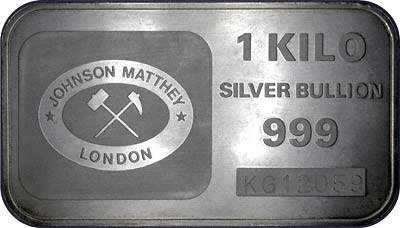
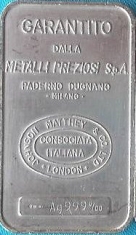

 Gold: $4,318.07
Gold: $4,318.07
 Silver: $64.87
Silver: $64.87
 Platinum: $1,928.53
Platinum: $1,928.53
 Palladium: $1,716.64
Palladium: $1,716.64
 Bitcoin: $85,406.15
Bitcoin: $85,406.15
 Ethereum: $2,825.83
Ethereum: $2,825.83
I have two lots of unused dental amalgam totaling 1.25 Kg. Amalgam is 75% silver. Would you be able to buy from me and what would you be prepared to pay?
Hi Malcolm, it’s best to get it appraised at your local gold dealer. Get quotes from various dealers preferably, to find the best price.
Good luck